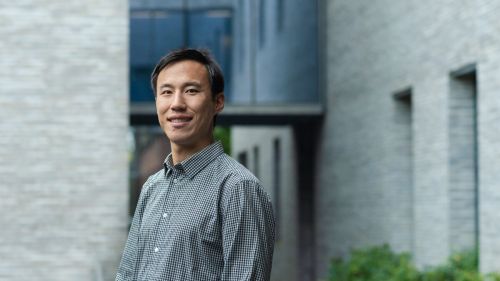
Nathaniel Wei Photo by Bumper DeJesus
As a Distinguished Postdoctoral Fellow, Nathaniel Wei will aid in the construction of a wind tunnel on Princeton’s Forrestal Campus that, when completed, will enable cutting-edge investigations into atmospheric dynamics.
The Andlinger Center for Energy and the Environment has selected Nathaniel Wei as a Distinguished Postdoctoral Fellow, supporting his exploration of atmospheric dynamics to realize the full potential of wind energy.
Wei will work with Marcus Hultmark, professor of mechanical and aerospace engineering, and Elie Bou-Zeid, professor of civil and environmental engineering, to study how atmospheric dynamics influence wind energy production.
As a Distinguished Postdoctoral Fellow, Wei will aid in the construction of a wind tunnel on Princeton’s Forrestal Campus that, when completed, will enable cutting-edge investigations into atmospheric dynamics. Wei said the fine-tunability of the wind tunnel will allow researchers to study stable boundary layers with unprecedented precision. Stable boundary layers are cool layers of air above the Earth’s surface that commonly form over the land at night when ground temperatures drop. By better understanding the dynamics of these layers, researchers can inform efforts to improve the performance of wind turbines at night, when solar panels are no longer producing energy.
In addition to his work on the wind tunnel, Wei plans to leverage the mobile sensing capabilities of drones to fill in missing information about atmospheric flows. While most climate modeling approaches have relatively coarse resolutions of a kilometer or greater, and most experimental techniques are constrained to measure flows at either single points or much smaller volumes, less is understood about atmospheric dynamics between these scales – a gap in the scientific literature that Wei said is often referred to as the terra incognita (“unknown land”) of atmospheric dynamics.
“Something like a 100-meter length scale is too small for most climate simulations to capture and too large for existing experimental techniques, even though it has important real-world implications,” Wei said. “For example, if you wanted to understand how pollutants from a factory are dispersed to the surrounding environment, a better understanding of atmospheric flows at the 100-meter scale is incredibly important.”
Wei’s postdoctoral work will expand on a research career dedicated to experimental fluid mechanics and their applications to wind energy. During his graduate work at Stanford University and the California Institute of Technology, Wei researched vertical-axis wind turbines, an alternative to the horizontal-axis wind turbines that most people associate with wind energy. Vertical-axis wind turbines can produce energy regardless of the incoming wind direction, and they have the potential to be packed into much tighter arrays than other forms of wind energy, leading to greater power production per unit of land area. Wei also studied ways to optimize power production from offshore wind farms, counterintuitively finding that allowing floating turbines to rock back and forth in the ocean could actually lead to greater efficiencies than securing them in a fixed location.
During the fellowship, Wei said he looks forward to not only uncovering new insight about how the atmosphere works, but also to the opportunity he will have at the Andlinger Center to interact with energy and environmental researchers from across many disciplines.
“None of the clean energy problems I work on are purely technical in their approach,” Wei said. “Even if we knew how to build the world’s most optimized wind farm, we would still need to put it somewhere. We would still need the backing of local communities. And even after it gets built, we would need policies in place to support wind development and maintenance. One of the things I am most looking forward to about the Andlinger Center is that I’ll have the chance to interact with researchers tackling energy problems from every angle.”
To learn more about the other Fellows and the fellowship program, read the full release.